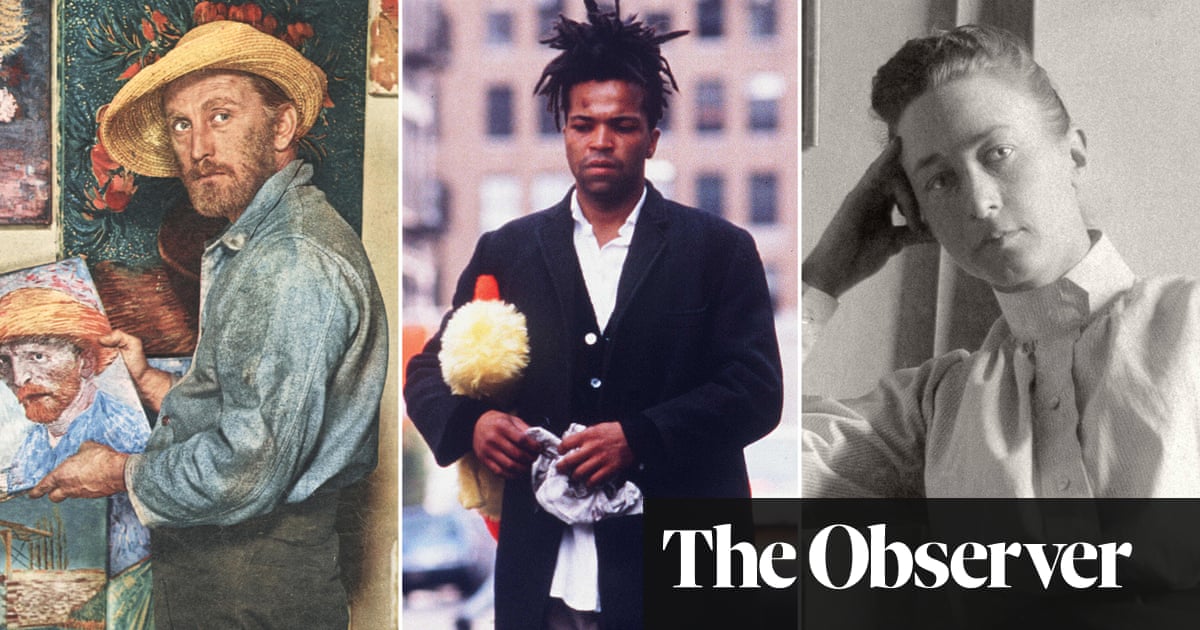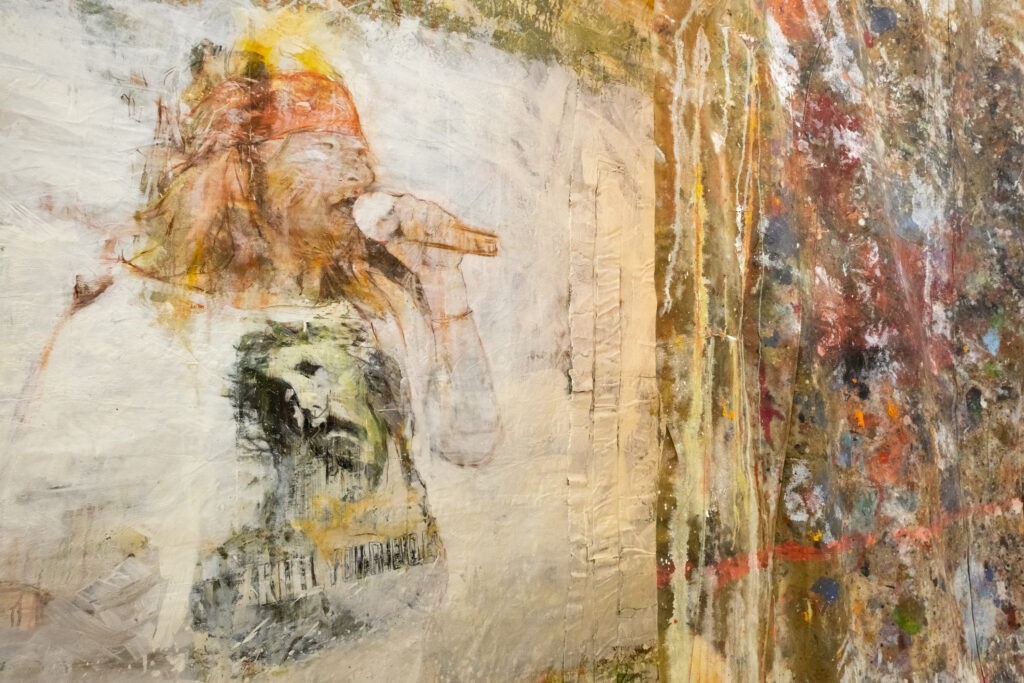Untitled (Zimbabwe)
2009 - Painting (Painting)
60 x 117.2 cm
Fred Wilson
Fred Wilson’s flag paintings document the 20th century history of African people, indexing the period of liberation from colonialism. As the majority of African flags were created during the 1950s and 60s, they were intended to reflect a so-called ‘modern’ aesthetic and ideology. Many African flags maintain the typical flag tropes such as stripes, stars, birds, and blocks of primary and secondary colors; green to represent the land; blue to symbolize the ocean or sky; and red to recall the violence that occured in the pursuit of liberty. These colors indicate tribal, cultural, religious, national, and political identities. Some African flags, however, also contain black, representing the people, in order to distinguish them from the European countries that colonized them. Focusing on the significance of this black, Fred Wilson pushes this aesthetic to the extreme by creating a series of painting flags that strips them of the colors, reducing them to their most basic components. Untitled (Zimbabwe) features raw cotton canvas, overlain with a series of horizontal black stripes, the middle of which has been filled in black. To the left, a triangle containing a star and the national bird of Zimbabwe is rendered in graphic precision. Through the absence of color, Wilson’s paintings call attention to the dynamic and mutable nature of African nations, their identities, and their histories, but also the loss experienced in the pursuit of sovereignty.
Fred Wilson’s conceptual art practice encompasses sculpture, painting, photography, collage, printmaking, and installation. His work tends to subvert perceptions in order to reveal the undercurrents of historical discourse, ownership, and privilege normalized by institutional practices. Wilson interdisciplinary work challenges dominant narratives about history, culture, race, and conventions of display. By reframing objects and cultural symbols, he alters traditional interpretations, encouraging viewers to reconsider social and historical narratives. His groundbreaking exhibition Mining the Museum (1992) at the Maryland Historical Society radically altered the landscape of museum exhibition narratives. As interventions, or “mining,” of the museum’s archive, Wilson re-presented its materials to make visible hidden structures built into the museum system, and American society as a whole.
Colors:
Related works sharing similar palette

© » ARTSY
Diana Al-Hadid’s Monumental, Spiky Bronzes Examine Feminine Strength and Fragility | Artsy Skip to Main Content Advertisement Art Diana Al-Hadid’s Monumental, Spiky Bronzes Examine Feminine Strength and Fragility Rawaa Talass Nov 16, 2023 5:13PM Diana Al-Hadid The Bride in the Large Glass , 2023 Kasmin Price on request Portrait of Diana Al-Hadid by Diego Flores...

© » KADIST
Margo Wolowiec
2017Imagine How Many by Margo Wolowiec is a woven polyester depiction of blurred text and floral images found on social media, distorted beyond complete recognition...

© » ARTS EQUATOR
Podcast: Singapore Theatre Festival 2018 | ArtsEquator Thinking and Talking about Arts and Culture in Southeast Asia ArtsEquator Viewpoints August 2, 2018 Duration: 48 min Matt Lyon and Naeem Kapadia are back on ArtsEquator’s theatre podcast, and with a bang: nearly an hour’s worth of discussion on the Singapore Theatre Festival 2018 which just ended on 22 July...

© » KADIST
Kamau Amu Patton
2011Kamau Amu Patton’s painting Static Field I originates from a system of electronic and digital media...

© » ARTS EQUATOR
Nghệ thuật Xin giấy phép Triển lãm ở Việt Nam | ArtsEquator Skip to content Tại một đất nước như Việt Nam, nơi có những yêu cầu không rõ ràng về việc trưng bày, Linh Lê nhấn mạnh rằng chỉ cần một thứ tưởng chừng đơn giản như xin giấy phép triển lãm có thể trở thành một cách kiểm duyệt biểu đạt nghệ thuật...

© » KADIST
Jonas Bendiksen
2021For his project Book of Veles artist Jonas Bendiksen travelled to the small city of Veles in North Macedonia, inspired by a series of press reports starting in 2016, that revealed Veles as a major source of the fake news stories flooding Facebook and other social media sites celebrating Donald Trump and denigrating Hillary Clinton...

© » HYPERALLERGIC
New Bedford Whaling Museum Restores Rare Panorama Painting Skip to content Conservation efforts to restore Charles Sidney Raleigh’s “Panorama of a Whaling Voyage” (1878–80) This December, the New Bedford Whaling Museum revealed the groundbreaking restoration of one panel from Charles Sidney Raleigh’s “Panorama of a Whaling Voyage” (1878–80)...

© » ARTSJOURNAL
Streaming: the best films about artists | Movies | The Guardian Skip to main content Skip to navigation Skip to navigation From left: Kirk Douglas as Vincent van Gogh in Vincente Minnelli's ‘unabashedly gorgeous' Lust For Life (1956); ‘raw, restless' Jeffrey Wright in Julian Schnabel's Basquiat (1996); the Swedish artist and mystic Hilma af Klint in Halina Ryschka's documentary Beyond the Visible (2019)...

© » KADIST
Christopher Badger
2011In mathematics, the so-called geometric problems of antiquity are shapes that elude the classical tools of an unmarked straightedge and compass...

© » KADIST
Rivane Neuenschwander
2007Mapa-Mundi BR (postal) is a set of wooden shelves holding postcards that depict locations in Brazil named for foreign countries and cities...

© » KADIST
Women Art Revolution Alicia Smith, Amapola Prada, Claudia Joskowicz, Clarisse Hahn, Fang Lu, Laura Huertas Millán, Lynn Hershman Leeson, siren eun young jung Women Art Revolution draws a selection of works from the KADIST collection that aim to initiate conversations around women’s issues, feminism, and feminist art...

© » KADIST
Ícaro Lira
2012Icaro Lira has been developing the project “Museum of the Foreigner” since 2015, in which he recounts the trajectories of populations inside Brazil, from the north to the big cities of the south...

© » SLASH PARIS
40 ans du Frac ! — Gunaikeîon — Frac île-de-france, les Réserves — Exhibition — Slash Paris Login Newsletter Twitter Facebook 40 ans du Frac ! — Gunaikeîon — Frac île-de-france, les Réserves — Exhibition — Slash Paris English Français Home Events Artists Venues Magazine Videos Back 40 ans du Frac ! — Gunaikeîon Exhibition Mixed media Vue de l’exposition 40 ans du Frac ! — Gunaikeîon au Frac île-de-france, les Réserves, Romainville © Frac Île-de-France 40 ans du Frac ! Gunaikeîon Ends in 2 months: October 15, 2023 → February 24, 2024 Pour les 40 ans des Frac, il s’agit à la fois de repenser l’histoire de l’institution, écrite notamment par le biais de sa collection, et de tendre vers des futurs communs et désirables...







